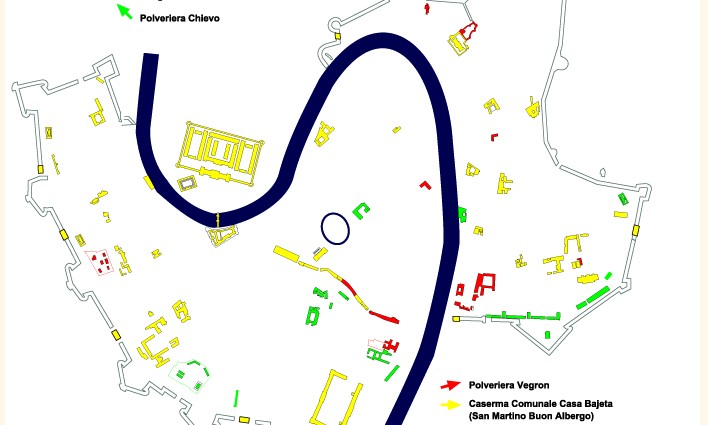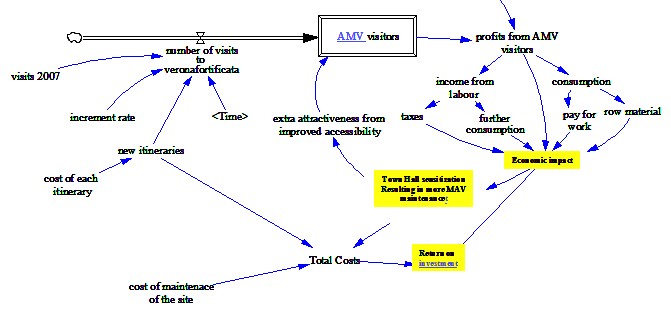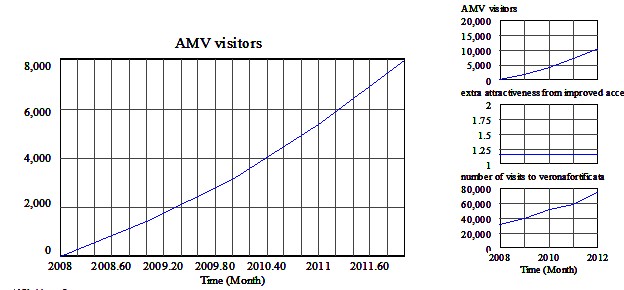The Veronese Military Architecture
A System Dynamics Based Model
Arnaldo Vecchietti
arnaldo_vecchietti@comune.verona.it

Presentation of a System Dynamics model to evaluate the economic impact and the return on investment done investing on www.veronafortificata.it and MAVGIS
Let me introduce now an easy model which highlights some of the economic aspects of the enhancement process of our military architecture via the site veronafortificata.
When we decided to invest in the site to promote our cultural assets we didn’t think we needed to invest large sums of money to have respectable return on investment. I would like speak briefly about the considerations we made before embarking on the project.
In fact we don’t have enough money to restore the system. This because the system is huge but also because the system has to find a way itself to survive. If it doesn’t the system is already dead. The public authority’s job is only start the process. Let me show you how that could happen.
We start with a site.
The site Veronafortificata would support the enhancement process of one of the military architecture system of Verona.
That is a cultural asset for us. With this asset our city can reshape what it has to offer tourists; it can increase points of interest in the territory and use the interest of tourists in the system as evidence of its value..
So Veronafortificata was given by the former administration the role of enhancing the identity of these cultural assets. To safeguard the history of our military architecture meant for the former sponsor of the UVAM initiative to give to walls and forts a role in contemporary society.
A role which takes into account economy, history, culture, quality of life as a whole for the citizens, immigrant population and also for visitors who live and stay in Verona.
To do this veronafortificata promoted at many levels the cultural value of the military architecture for the community. The main activities consisted in activating a cultural tam tam, a kind of storytelling and in boosting project activities for our military architecture.
 All the activities were focused on one aim, to improve the number of visitors. Despite the poor conditions of maintenance of the walls and forts, it was important that people were interested in them.
We decided that to supply itineraries and content with the site was the right way.
Taking a look at this model you can appreciate why it is so important to follow this approach.
If we were able to improve the number of visitors of our military architecture for example by bringing the number up to 8.000 , we could produce an economic impact of more than one million euros!
To produce this effect we considered that we needed to increase the number of visitors to the site veronafortificata to eight thousand and imagine that 1% of them would eventually become visitors of the real architecture here in Verona.
We also considered that an improved maintenance of walls and forts could improve the attractiveness of them by 25%.
All the activities were focused on one aim, to improve the number of visitors. Despite the poor conditions of maintenance of the walls and forts, it was important that people were interested in them.
We decided that to supply itineraries and content with the site was the right way.
Taking a look at this model you can appreciate why it is so important to follow this approach.
If we were able to improve the number of visitors of our military architecture for example by bringing the number up to 8.000 , we could produce an economic impact of more than one million euros!
To produce this effect we considered that we needed to increase the number of visitors to the site veronafortificata to eight thousand and imagine that 1% of them would eventually become visitors of the real architecture here in Verona.
We also considered that an improved maintenance of walls and forts could improve the attractiveness of them by 25%.
 The collateral effect of that economic impact would be the stimulation of a new interest on the part of the city in maintaining walls and forts as had already happened for the other monuments in the city.
The economic impact is not limited only to the income from visitors during the visiting day. We considered that if each tourist spent 50 euros per day of the four hundred thousand euros spent globally, it would generate another six hundred thousand euros in further consumption, taxes and pay for work.
Without sensitizing people to the cultural value of the walls and forts, it is very difficult to imagine a positive future for our military architecture. So sensitisation is the key to introducing the potential value of maintaining military architecture to the people. A successful sensitization campaign could result in the Town Hall in investing in the maintenance of walls and forts. In this simulation we put a very small sum for the maintenance only to appreciate its effect for extra attractiveness. We haven’t simulated the effect of an increase in a new positive attitude to military architecture; if walls and forts have a higher social value, this could surely become an extra coefficient to apply to the simulation.
An extra coefficient which could help everyone to understand that a cultural asset is a gift from the past which gives new opportunities for the future.
We think that it’s very important to highlight and to emphasize the relevance of the economic aspects in restoring, renovating and reusing monuments. This because we have to understand that it is financially important to invest in our cultural assets. Without that awareness I think it will be very difficult improve the present situation.
In the simulation we can show and naturally explain that a ROI of nine hundred per cent is really not bad, right?
The collateral effect of that economic impact would be the stimulation of a new interest on the part of the city in maintaining walls and forts as had already happened for the other monuments in the city.
The economic impact is not limited only to the income from visitors during the visiting day. We considered that if each tourist spent 50 euros per day of the four hundred thousand euros spent globally, it would generate another six hundred thousand euros in further consumption, taxes and pay for work.
Without sensitizing people to the cultural value of the walls and forts, it is very difficult to imagine a positive future for our military architecture. So sensitisation is the key to introducing the potential value of maintaining military architecture to the people. A successful sensitization campaign could result in the Town Hall in investing in the maintenance of walls and forts. In this simulation we put a very small sum for the maintenance only to appreciate its effect for extra attractiveness. We haven’t simulated the effect of an increase in a new positive attitude to military architecture; if walls and forts have a higher social value, this could surely become an extra coefficient to apply to the simulation.
An extra coefficient which could help everyone to understand that a cultural asset is a gift from the past which gives new opportunities for the future.
We think that it’s very important to highlight and to emphasize the relevance of the economic aspects in restoring, renovating and reusing monuments. This because we have to understand that it is financially important to invest in our cultural assets. Without that awareness I think it will be very difficult improve the present situation.
In the simulation we can show and naturally explain that a ROI of nine hundred per cent is really not bad, right?
|